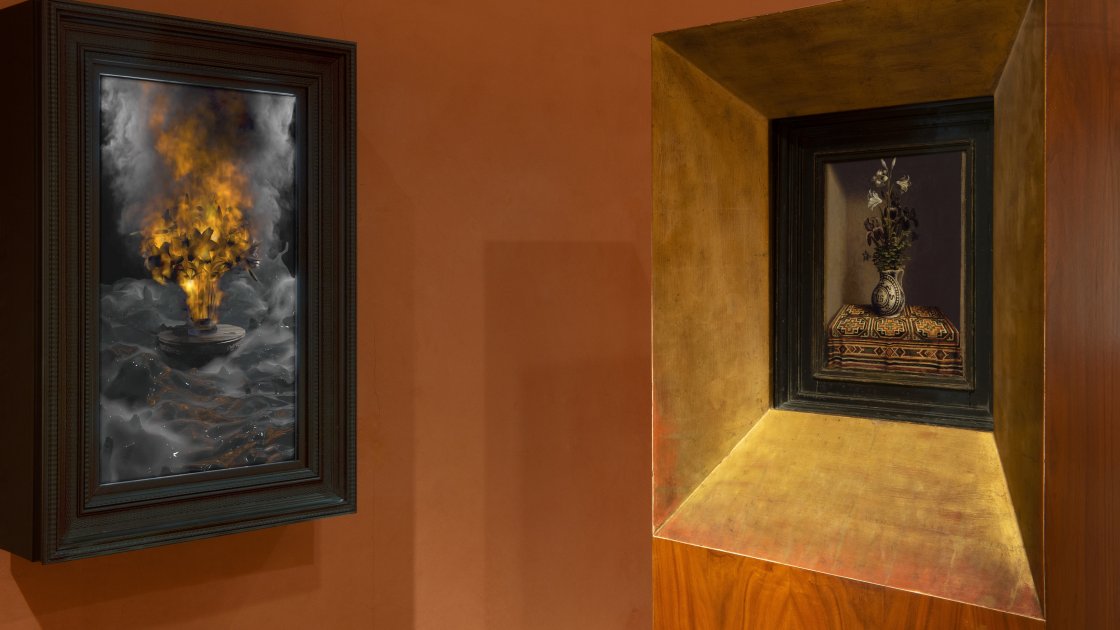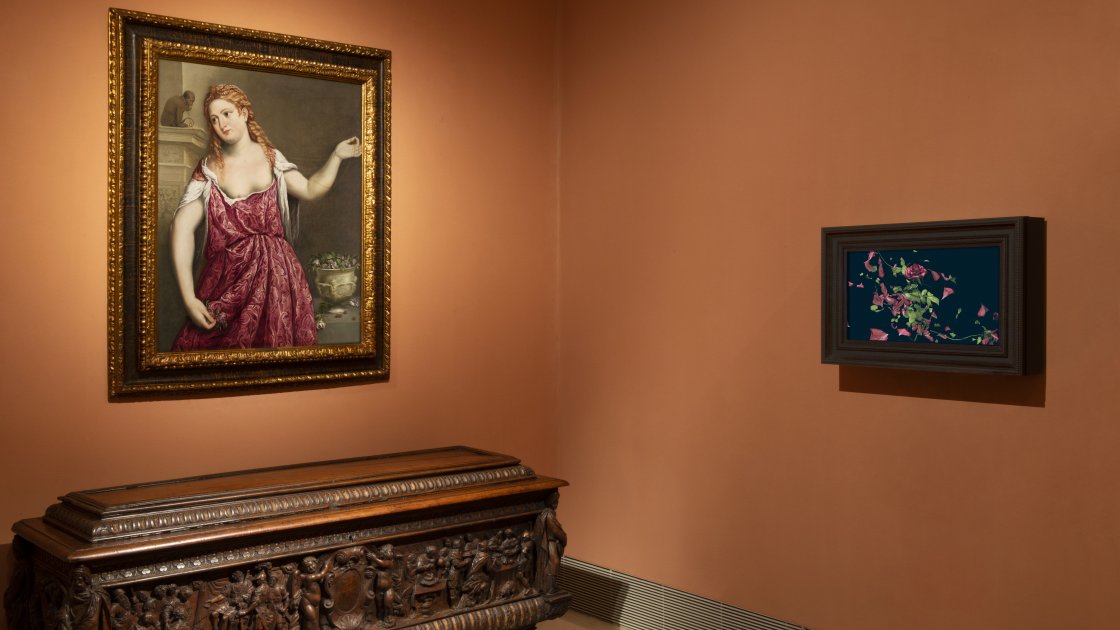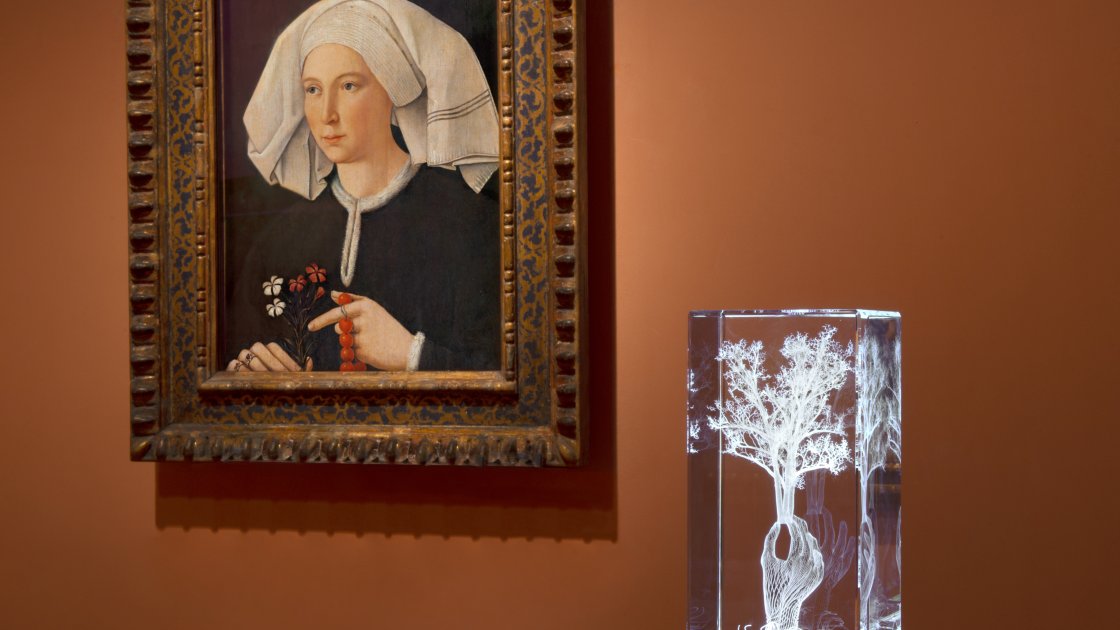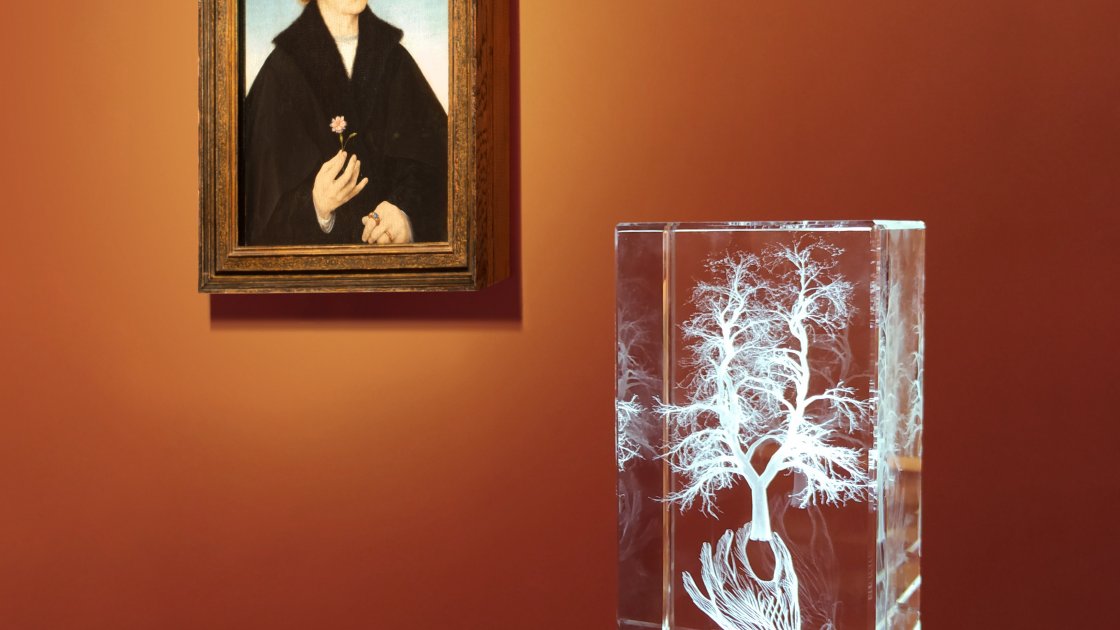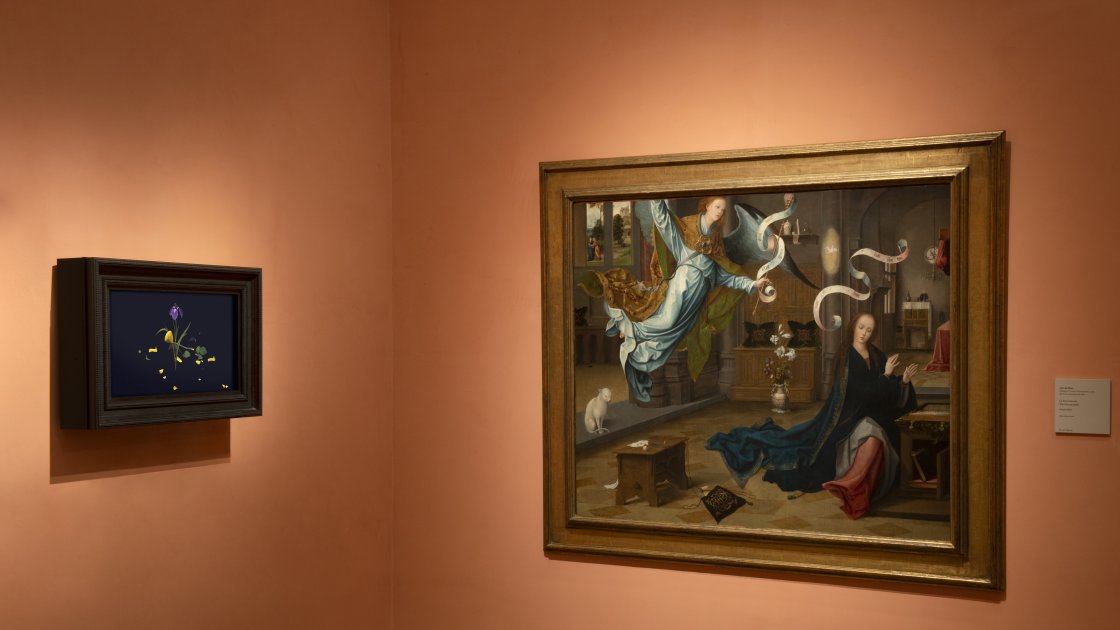Contenido adicional
Marina Núñez. Vanitas es la cuarta edición del programa “Kora”, comisariado por Rocío de la Villa, que cada año trae a las salas del museo una exposición concebida desde la perspectiva de género. La muestra reúne un total de quince obras, incluyendo pinturas al óleo, vídeos y piezas de cristal tallado con láser, algunas creadas especialmente para la muestra. Diez de ellas se presentan en la sala del Balcón, con acceso directo desde el hall del museo, y cinco en diálogo con algunas pinturas del Renacimiento en las salas 5, 6 y 10 de la colección permanente.
En la tradición artística, los hombres eran identificados con racionalidad o progreso y pintaban cuadros heroicos, mientras que a las mujeres se les vinculaba con lo natural y lo primitivo y realizaban pinturas de flores. Consciente de esta infravaloración, Marina Núñez se aleja de esa concepción del bodegón como meramente ornamental y remite con su obra a la condición orgánica del ser humano y a su fragilidad, a la conexión entre el cuerpo y la naturaleza, encarnada en diversas variedades de flores, y a las transformaciones, tensiones y procesos que se derivan.
Tres pinturas al óleo, realizadas durante el periodo de confinamiento por la COVID19, reflejan la fusión de rostros humanos con rosas, iris o lirios, que actúan a modo de velo y de elemento transformador. Este motivo, muy presente en la carrera de Marina Núñez, fomentó el paso de la pintura al vídeo para transmitir de forma más expresiva esa metamorfosis. Prueba de ello son los vídeos de la serie Naturaleza (isla, manglar y montaña), que aluden a nuestro pasado colonial y a las explotaciones naturales y culturales de la civilización occidental, y Vanitas, que da título al proyecto y donde asistimos a un combate en el que dos bustos pétreos enfrentados terminan disolviéndose y transformándose en flores que surgen triunfantes entre la materia.
Esa misma idea de unión se refleja en la serie Marejada, tres dibujos a lápiz e impresión sobre madera en los que el cuerpo femenino se mezcla con formas vegetales, dando lugar a extraños y siniestros híbridos que flotan de manera sensual.
En las salas 5, 6 y 10 de la colección permanente, junto a obras como Florero de Hans Memling (reverso de Retrato de un hombre joven orante), la Anunciación de Jan de Beer y Retrato de una joven de París Bordone, se presentan tres vídeos de la serie Flores heroicas, en los que lirios, rosas e iris estallan en una combustión espontánea y renacen vencedoras en su combate contra las desigualdades.
Otra de sus series, Retratos, está formada por piezas grabadas con láser en cristal que representan manos ramificadas, prácticamente convertidas en árboles, una unión que asemeja el amor por la naturaleza al deseo de los desposados representado en obras de la colección con las que dialogan, como Autorretrato de Joos van Cleve o Retrato de una mujer de autor anónimo alemán.
Marina Núñez. Vanitas is the fourth edition of the “Kora” programme, curated by Rocío de la Villa, which presents an annual exhibition in the museum’s galleries devised from a gender perspective. This year’s event devoted to Marina Núñez presents a total of 15 works, including oil paintings, videos and laser-cut glass pieces, some specially created for this event. Ten of them are on display in the Balcony Gallery, with direct access from the museum’s Main Hall, while five establish dialogues with Renaissance paintings in the galleries of the permanent collection.
Within the tradition of art, men were identified with rationality and progress and created heroic paintings while women were associated with nature and the primitive and produced floral compositions. Aware of this incorrect appreciation, Marina Núñez has moved away from the idea of the still life as something merely ornamental and uses her work to refer to the organic nature of human beings and our vulnerability, to the connection between the body and nature, incarnated in different varieties of flowers, and to the transformations, tensions and processes arising from them.
Three oil paintings, painted during the COVID19 lockdown period, are based on the fusion of human faces with roses, irises and lilies which function in the manner of a veil and a transforming element. This motif, which is particularly present in the artist’s work, encouraged her to move from painting to video in order to convey this metamorphosis in a more expressive manner. Examples include the videos from the Nature (island, mangrove swamp and mountain) series, which refer to our colonial past and to western civilisation’s exploitation of the natural world and other cultures; and Vanitas, the work that provides the title for the project as a whole and which features a combat in which two stone busts eventually dissolve and turn into flowers that emerge triumphantly from among the material.
This idea of union is also present in the series Marejadas (Swells), comprising three pencil drawings with woodblock print in which the female body combines with plant forms to produce strange and sinister hybrids that float in a sensual manner.
Shown in Rooms 5, 6 and 10 of the permanent collection alongside works such as Vase of Flowers by Hans Memling (the reverse of Portrait of a young Man praying), The Annunciation by Jan de Beer and Portrait of a young Man by Paris Bordone are three videos from the series Heroic Flowers in which the lilies, roses and irises explode in a spontaneous combustion and are reborn as the victors in the struggle against inequalities.
Another of the artist’s series, Portraits, consists of laser-cut glass pieces that depict branching hands almost transformed into trees; a fusion which compares love of nature to the newly-wed sitters seen in works in the collection with which they establish a dialogue, such as Self-portrait by Joos van Cleve and Portrait of a Woman by an anonymous German artist.
Biografia de la artista
Marina Núñez (Palencia, 1966)
Licenciada en Bellas Artes por la Universidad de Salamanca y doctorada en Bellas Artes por la Universidad de Castilla La Mancha. Su obra forma parte de las colecciones de numerosas instituciones públicas como el Museo Nacional Centro de Arte Reina Sofía (Madrid), Es Baluard (Palma de Mallorca), el CAAM (Las Palmas), la Panera (Lleida), el CAB (Burgos), el FRAC Corse, el Artium (Vitoria), el MUSAC (León), el TEA (Tenerife), la Fundación La Caixa, la Fundación Botín (Santander), el Patio Herreriano (Valladolid), el MAC (La Coruña) o la American University (Washington D.C).
Actualmente vive entre Madrid y Pontevedra y es profesora titular de pintura en la Facultad de Bellas Artes de la Universidad de Vigo.
Artist bio
Marina Núñez (Palencia, 1966)
Marina Núñez graduated in Fine Arts from the University of Salamanca and has a PhD in that subject from the University of Castilla la Mancha. Her work is represented in numerous public institutions, including the Museo Nacional Centro de Arte Reina Sofía (Madrid), Es Baluard (Palma de Mallorca), the CAAM (Las Palmas), the Panera (Lleida), the CAB (Burgos), the FRAC Corse, the Artium (Vitoria), the MUSAC (León), the TEA (Tenerife), the Fundación La Caixa, the Fundación Botín (Santander), the Patio Herreriano (Valladolid), the MAC (La Coruña), and the American University (Washington D.C).
The artist currently lives in Madrid and Pontevedra and is a tenured professor of painting in the Fine Arts faculty at the University of Vigo.

